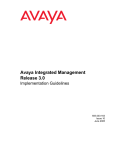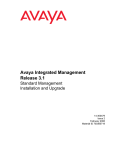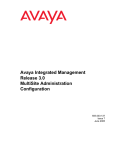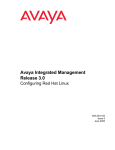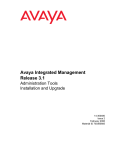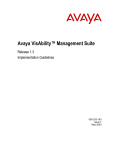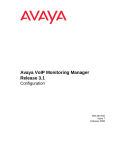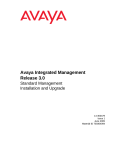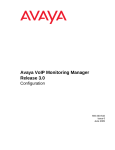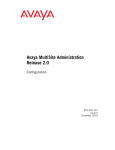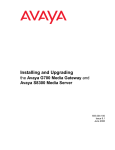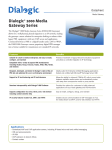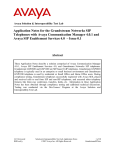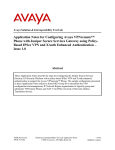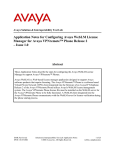Download Avaya Integrated Management Release 3.1 User's Manual
Transcript
Avaya Integrated Management Release 3.1 Implementation Guidelines 555-233-163 Issue 11 February 2006 © 2006 Avaya Inc. All Rights Reserved. Notice While reasonable efforts were made to ensure that the information in this document was complete and accurate at the time of printing, Avaya Inc. can assume no liability for any errors. Changes and corrections to the information in this document may be incorporated in future releases. For full legal page information, please see the complete document, Avaya Legal Page for Software Documentation, Document number 03-600758. To locate this document on the website, simply go to http://www.avaya.com/support and search for the document number in the search box. Documentation disclaimer Avaya Inc. is not responsible for any modifications, additions, or deletions to the original published version of this documentation unless such modifications, additions, or deletions were performed by Avaya. Customer and/or End User agree to indemnify and hold harmless Avaya, Avaya's agents, servants and employees against all claims, lawsuits, demands and judgments arising out of, or in connection with, subsequent modifications, additions or deletions to this documentation to the extent made by the Customer or End User. Link disclaimer Avaya Inc. is not responsible for the contents or reliability of any linked Web sites referenced elsewhere within this documentation, and Avaya does not necessarily endorse the products, services, or information described or offered within them. We cannot guarantee that these links will work all of the time and we have no control over the availability of the linked pages. Warranty Avaya Inc. provides a limited warranty on this product. Refer to your sales agreement to establish the terms of the limited warranty. In addition, Avaya’s standard warranty language, as well as information regarding support for this product, while under warranty, is available through the following Web site: http://www.avaya.com/support Copyright Except where expressly stated otherwise, the Product is protected by copyright and other laws respecting proprietary rights. Unauthorized reproduction, transfer, and or use can be a criminal, as well as a civil, offense under the applicable law. Avaya support Avaya provides a telephone number for you to use to report problems or to ask questions about your product. The support telephone number is 1-800-242-2121 in the United States. For additional support telephone numbers, see the Avaya Web site: http://www.avaya.com/support Contents Preface . . . . . . . . . . . . . . . . . . . . . . . . . . . . . . . . . . 5 Purpose. . . . . . . . . . . . . . . . . . . . . . . . . . . . . . . . . . . . . . . . . 5 Intended Audience. . . . . . . . . . . . . . . . . . . . . . . . . . . . . . . . . . . 5 Conventions Used in This Book . . . . . . . . . . . . . . . . . . . . . . . . . . . 5 Support Resources . . . . . . . . . . . . . . . . . . . . . . . Avaya Technology and Consulting (ATAC) . . . . . . . . Communications, Solutions, and Integration (CSI) Group of Software Services . . . . . . . . . . . . . . . . . . . . Avaya Technical Service Organization (TSO) . . . . . . . . . . . . . . . . . . . . . . . . . . . . . 6 6 . . . . . . . . . . . . . . . . . . . . . . 6 7 Avaya Network Management Software Systems Support Group (NMSSS) . . . . Customized Management Solutions for Avaya Integrated Management. . . . Avaya Contact Information . . . . . . . . . . . . . . . . . . . . . . . . . . . . 7 8 9 Additional Resources . . . . . . . . . . . . . . . . . . . . . . . . . . . . . . . . . 10 Product Documentation . . . . . . . . . . . . . . . . . . . . . . . . . . . . . . . . 13 How to Access Books on the Web . . . . . . . . . . . . . . . . . . . . . . . . . . 14 Tell Us What You Think! . . . . . . . . . . . . . . . . . . . . . . . . . . . . . . . . 14 Chapter 1: Application Environment . . . . . . . . . . . . . . . . . . . . 15 Overview . . . . . . . . . . . . . . . . . . . . . . . . . . . . . . . . . . . . . . . . 15 Voice and Messaging System Compatibility . . . . . . . . . . . . . . . . . . . . . 15 Operating Environment . . . . . . . . . . . . . . . . . . . . . . . . . . . . . . . . 16 Hardware and Software Components . . . . . . . . . . . . . . . . . . . . . . . . Server Requirements for VoIP Monitoring Manager. . . . . . . . . . . . . . . 18 18 Connectivity/Network Connections . . . . . . . . . . . . . . . . . . . . . . . . . 23 Remote Access Hardware and Software . . . . . . . . . . . . . . . . . . . . . . . 23 Symmetric Multi-Processor (SMP) Support . . . . . . . . . . . . . . . . . . . . . 23 Chapter 2: Implementation Services . . . . . . . . . . . . . . . . . . . . 25 Product Packaging . . . . . . . . . . . . . . . . . . . . . . . . . . . . . . . . . . 25 Customer Implementation Options . . . . . . . . . . . . . . . . . . . . . . . . . . 26 Overview of Avaya Implementation Services . . . . . . . . . . . . . . . . . . . . Basic Implementation . . . . . . . . . . . . . . . . . . . . . . . . . . . . . . . 26 27 Services Organizations Involved in Avaya Integrated Management Implementations. Service Request Documentation . . . . . . . . Implementation Request Form . . . . . . . Configuration Request Form . . . . . . . . . . . . 28 29 29 29 Avaya and Customer Responsibilities . . . . . . . . . . . . . . . . . . . . . . . . 30 . . . . . . . . . . . . . . . . . . . . . . . . . . . . . . . . . . . . . . . . . . . . . . . . . . . . . . . . . . . . . . . . Issue 11 February 2006 3 Contents Specific Implementation Tasks . . . . . . . . . . . . . . . . . . . . . . . Remote Connectivity . . . . . . . . . . . . . . . . . . . . . . . . . . Computing Platform . . . . . . . . . . . . . . . . . . . . . . . . . . . IP Connectivity . . . . . . . . . . . . . . . . . . . . . . . . . . . . . . Application Installation and Configuration . . . . . . . . . . . . . . Implementation Verification . . . . . . . . . . . . . . . . . . . . . . . Avaya Fault and Performance Manager and Avaya Proxy Agent. Avaya MultiSite Administration . . . . . . . . . . . . . . . . . . . Avaya SMON Manager . . . . . . . . . . . . . . . . . . . . . . . . Avaya VoIP Monitoring Manager . . . . . . . . . . . . . . . . . . Avaya Site Administration. . . . . . . . . . . . . . . . . . . . . . Avaya Voice Announcement Manager . . . . . . . . . . . . . . . Avaya Provisioning and Installation Manager . . . . . . . . . . . . . . . . . . . . . . . . . . . . . . . . . . . . . . . . . . . . . . . . . . . . . . . . . . . . . . . . . . . . . . . . . . . . 31 31 32 33 33 33 34 34 35 35 36 36 36 Appendix A: Overview of Responsibilities . . . . . . . . . . . . . . . . 37 Appendix B: Installation of Red Hat Linux . . . . . . . . . . . . . . . . . 41 Overview . . . . . . . . . . . . . . . . . . . . . . . . . . . . . . . . . . . . . . . . 41 Installing Red Hat Enterprise Linux ES 4.0 or Red Hat Enterprise Linux AS 4.0 . . . . . . . . . . . . . . . . . . . . . . . . . . 41 Upgrading Red Hat Enterprise Linux ES 3.0 or AS 3.0 to Red Hat Enterprise Linux ES 4.0 or AS 4.0 . . . . . . . . . . . . . . . . . . . . . 44 Installing Additional Software. . . . . . . . . . . . . . . . . . . . . . . . . . . . . 45 Determining Whether RPM Files are Already Installed . . . . . . . . . . . . . . . 46 Installing RPM Files . . . . . . . . . . . . . . . . . . . . . . . . . . . . . . . . . . 46 Security Considerations. . . . . . . . . . . . . . . . . . . . . . . . . . . . . . . . 47 Appendix C: Sample VMM Configurator . . . . . . . . . . . . . . . . . . 49 Index 51 . . . . . . . . . . . . . . . . . . . . . . . . . . . . . . . . . . 4 Implementation Guidelines Preface Purpose This book provides the customer with an overall strategy for implementation of Avaya Integrated Management applications. It describes the roles and responsibilities of the customer and Avaya Services in the implementation of the applications. This book addresses: ● Pre-implementation requirements of the network management computing platforms ● Pre-implementation installation of the operating system on the computing platforms ● Post-implementation verification checklist The Avaya Data Network Implementation Engineering team (formerly RNIS) provides implementation services for Avaya Integrated Management applications. See Support Resources on page 6 for more information about planning, consulting, and technical services that are available from Avaya. Avaya Authorized Business Partners may also provide implementation services. Details of implementation services offered by business partners must be obtained from the business partners and are not discussed in book. Intended Audience This book is intended for customers to describe the roles and responsibilities of the customer and Avaya Services in the implementation of Avaya Integrated Management applications. Conventions Used in This Book The following typographical conventions are used: ● Bold type is used to indicate information that you type, buttons in a window, and the Enter key on the keyboard. It is also used for emphasis. ● Courier font is used for any information that the computer screen displays. ● Arrows indicate options that you select from cascading menus; for example, “Select File > Open” means choose the “Open” option from the “File” menu. Issue 11 February 2006 5 Preface Support Resources Avaya provides a variety of planning, consulting, and technical services. The following sections describe the resources and services that are available. Avaya Technology and Consulting (ATAC) Avaya Technology and Consulting (ATAC) works with client teams to develop detailed solutions for connectivity to Avaya Communication Manager solutions. The ATAC also designs network configurations. Communications, Solutions, and Integration (CSI) Group of Software Services Avaya Communications, Solutions, and Integration (CSI) Group of Software Services offers customers the following services: ● Platform readiness verification ● Remote implementation and installation ● Network management server configuration ● Customer acceptance verification ● Custom on-site services The CSI Group consists of the following two teams: ● Converged Solutions Implementation Engineering The Converged Solutions Implementation Engineering (CSIE) team implements multi-site media gateway (G350/G650/G700) deployment projects for both voice and data design. The overall direction of the CSIE team is to bring the correct methodology to these complex deployments that span various regions and to provide continuity to the overall project from the voice and data implementation standpoint. ● Data Network Implementation Engineering (formerly RNIS) The Data Network Implementation Engineering team implements and/or upgrades existing or new data networks. This team analyzes the customer’s network design requirements and performance expectations, and then creates the hardware and software installation specification used to implement data devices including Cajun, VPN, Wireless LAN, Secure Gateways, Extreme, and multi-vendor data equipment. 6 Implementation Guidelines Avaya Network Management Software Systems Support Group (NMSSS) The CSI Group provides support on a contract basis. You can purchase various implementation offers from the CSI Group in Tampa, Florida. See Table 1: Customer-Accessible Resources on page 9 for contact information. Avaya Technical Service Organization (TSO) The Avaya Technical Service Organization (TSO) provides support to the Avaya Integrated Management client teams, field technicians, and customers. The TSO will bill customers for support on a time and materials basis if the following conditions exist: ● Customers do not provide remote access. ● Customers do not have a current maintenance agreement. ● Customers do not procure and install the required systems and software as defined in the Integrated Management Services Support Plan. ● Customers request support that is outside the purchase agreement. The TSO does not support hardware or software that customers purchase from third-party vendors. Avaya Network Management Software Systems Support Group (NMSSS) The Avaya Network Management Software Systems Support Group (NMSSS) in Tampa Bay, Florida answers customer calls about products in Avaya Integrated Management. NMSSS will either answer your questions directly or connect you with an associate who can answer questions about the products. Issue 11 February 2006 7 Preface Customized Management Solutions for Avaya Integrated Management The Integrated Management Product Team understands customer’s needs and is focused on customer satisfaction. See Table 1: Customer-Accessible Resources on page 9 for contact information. The Product Team will assist customers with Avaya Integrated Management projects and will provide: ● Project Management — An Integrated Management project person will work with the customer to access configuration and customization requirements for any or all applications within each Avaya Integrated Management offer. If custom work is required, the evaluation will include a proposed statement of work and price. Note that this offer is not intended to provide installation for customers that choose to implement Integrated Management applications using Avaya Services or third-party implementation services. ● Training — Basic training can be performed remotely using an interactive medium to display the applications and a conference bridge for audio. On-site training can be customized to meet the customer’s needs. Customized training will focus on application functionality that is relevant to the customer and provide focused knowledge transfer to facilitate application-specific training. 8 Implementation Guidelines Avaya Network Management Software Systems Support Group (NMSSS) Avaya Contact Information Table 1 and Table 2 provide contact information that you may use if you need assistance during the process of installing and setting up Avaya Integrated Management. To access the links in Table 2, you must be able to access the Avaya intranet. Table 1: Customer-Accessible Resources Resource Contact Information Avaya Support Center http://www.avaya.com/support Network Management Software Systems Support (NMSSS) +1 800 237-0016 Communications, Solutions, and Integration (CSI) Group of Software Services +1 800 730-9108, prompt 3 Integrated Management Product Team Send email to: [email protected] Toll Fraud Intervention +1 800 643-2353, prompt 1 Table 2: Avaya Internal Resources Resource Contact Information Avaya System Management Support http://aem-support.dr.avaya.com Avaya Technology and Consulting (ATAC) +1 888 297-4700, prompt 2,6 http://forum.avaya.com (requires a password) Communications, Solutions, and Integration (CSI) Group of Software Services http://associate2.avaya.com/sales_market/products/ data-implementation-services/ Integrated Management Services Support Plan http://associate2.avaya.com/solution/support_plans/#Enterprise Issue 11 February 2006 9 Preface Additional Resources All Avaya Integrated Management Release 3.1 documents are listed in the following tables: ● Table 3: Overview Guides on page 10 ● Table 4: Installation and Upgrade Guides on page 10. ● Table 5: Configuration Guides on page 11. ● Table 6: Help Systems on page 11. ● Table 7: Network Management Applications on page 12. ● Table 8: Device Managers on page 13. Table 3: Overview Guides Document Title Document Number Avaya Integrated Management Release 3.1, Implementation Guidelines 555-233-163 Avaya Integrated Management Release 3.1, Overview 14-300615 Table 4: Installation and Upgrade Guides Document Title Document Number Avaya Integrated Management Release 3.1, Enterprise Network Management Installation and Upgrade 14-300444 Avaya Integrated Management Release 3.1, Network Management for Solaris Installation and Upgrade 14-300445 Avaya Integrated Management Release 3.1, VoIP Monitoring Management Installation and Upgrade 14-300446 Avaya Integrated Management Release 3.1, System Management Installation and Upgrade 14-300448 Avaya Integrated Management Release 3.1, Standard Management Installation and Upgrade 14-300479 Avaya Integrated Management Release 3.1, Administration Tools Installation and Upgrade 14-300480 10 Implementation Guidelines Additional Resources Table 5: Configuration Guides Document Number Document Title Avaya Integrated Management Release 3.1, MultiSite Administration Configuration 555-233-137 Avaya Integrated Management Release 3.1, Fault and Performance Manager Configuration 555-233-138 Avaya Integrated Management Release 3.1, Proxy Agent Configuration 555-233-139 Avaya Integrated Management Release 3.1, Configuring Red Hat Linux 555-233-152 Avaya Integrated Management Release 3.1, VoIP Monitoring Manager Configuration 555-233-510 Avaya Integrated Management Release 3.1, Integrated Management Database Configuration 14-300039 Avaya Integrated Management Release 3.1, Enterprise Network Management Configuration 14-300210 Avaya Integrated Management Release 3.1, Provisioning and Installation Manager Configuration 14-300286 Table 6: Help Systems Document Number Printable PDF Help System Avaya Integrated Management Release 3.1, MultiSite Administration Reference 14-300607 Avaya Integrated Management Release 3.1, Fault and Performance Manager Reference 14-300608 Avaya Integrated Management Release 3.1, Site Administration Reference 14-300610 Avaya Integrated Management Release 3.1, Integrated Management Database Reference 14-300611 Avaya Integrated Management Release 3.1, Provisioning and Installation Manager Reference 14-300612 Avaya Integrated Management Release 3.1, Voice Announcement Manager Reference 14-300613 Avaya Integrated Management Release 3.1, VoIP Monitoring Manager Reference 14-300614 Issue 11 February 2006 11 Preface Table 7: Network Management Applications Document Title Document Number Avaya Integrated Management Release 3.1, Address Manager User Guide 14-300170 Avaya Integrated Management Network Configuration Manager User Guidea 14-300167 Avaya Integrated Management Release 3.1, Network Management Console User Guide 14-300169 Avaya Integrated Management Reference Guide a 14-300531 Avaya Integrated Management QoS Manager User Guidea 14-300216 Avaya Integrated Management Release 3.1, SMON Manager User Guide 14-300209 Avaya Integrated Management Release 3.1, Software Update Manager User Guide 14-300168 Avaya Integrated Management Release 3.1, Secure Access Administration User Guide 14-300537 Avaya Integrated Management Release 3.1, Address Manager User Guide 14-300170 a. This document was not updated for Release 3.1. 12 Implementation Guidelines Product Documentation Table 8: Device Managers Document Title Document Number Avaya Integrated Management C360 Manager User Guide a 14-300164 Avaya Integrated Management C360 SMON User Guidea 14-300207 Avaya Integrated Management C460 Manager User Guidea 14-300224 Avaya Integrated Management C460 SMON User Guidea 14-300225 Avaya Integrated Management Release 3.1, G350 Manager User Guide 14-300166 Avaya Integrated Management P130 Manager User Guidea 14-300218 Avaya Integrated Management P130 SMON User Guidea 14-300219 Avaya Integrated Management P330 Manager User Guidea 14-300221 Avaya Integrated Management P330 SMON User Guidea 14-300222 Avaya Integrated Management P330 Load Balancing Manager User Guidea 14-300223 Avaya Integrated Management W310 Manager User Guidea 14-300163 Avaya Integrated Management W310 SMON User Guidea 14-300208 a. This document was not updated for Release 3.1. Product Documentation The latest version of Avaya Integrated Management product documentation, including this book, is available from the Avaya Support Web Site. To view or download these books from the Web, you must have access to the Internet, an Internet browser, and Adobe Acrobat Reader, version 5.0 or later. Adobe Acrobat Reader is provided on the Avaya Integrated Management CDs and is also available from http://www.adobe.com. See How to Access Books on the Web for instructions on how to view or download these books. Issue 11 February 2006 13 Preface How to Access Books on the Web To view or download books from the Avaya Support Web Site, follow these steps: 1. Access http://www.avaya.com/support. 2. Click Find Documentation and Downloads by Product Name. 3. Click the letter I in the alphabet listing. 4. Locate the Integrated Management product or offer name and click the corresponding link. 5. Click View All Documents to display a list of available books for that product or offer. Tell Us What You Think! Let us know how this book measured up to your expectations. Your opinions are crucial to helping us meet your needs! Send us your comments by mail, fax, or e-mail as follows: Mail: Avaya Inc. Avaya Integrated Management Documentation Team Room 3C-313 307 Middletown Lincroft Rd. Lincroft, NJ 07738 USA Fax: Avaya Integrated Management Documentation Team + 1 732 852-2469 E-mail: Subject: [email protected] Avaya Integrated Management Documentation Team 14 Implementation Guidelines Chapter 1: Application Environment Overview Avaya Integrated Management provides a standards-based infrastructure for an open application program interface and integrated network management in a converged, multi-vendor environment. Avaya Integrated Management is comprised of a set of applications that provide systems administration, network management, and business integration in a converged voice and data environment. While many of the individual management products have been available on an individual basis, Avaya Integrated Management integrates voice-centric management products and data-centric management products and provides a common user interface. Voice and Messaging System Compatibility The Avaya Integrated Management products manage devices using IP. All adjunct devices and non-IP enabled devices may relay alarms to the Avaya Proxy Agent using dial-up (serial) alarming. Avaya Integrated Management is compatible with voice systems, messaging systems, and call management systems as shown in Table 9. Table 9: Avaya Integrated Management System Compatibility System Release DEFINITY R, DEFINITY SI, DEFINITY CSI, DEFINITY ONE, IP600 Release 9, 10 or MultiVantage (System must be configured for IP administration) S8100 Media Server MultiVantage S8300 Media Server MultiVantage and later or Communication Manager S8500 Communication Manager S8700 Media Server MultiVantage and later or Communication Manager S8710 Media Server MultiVantage and later or Communication Manager 1 of 2 Issue 11 February 2006 15 Application Environment Table 9: Avaya Integrated Management System Compatibility (continued) System Release INTUITY AUDIX Release 5.1 and later INTUITY AUDIX LX Release IA 1.0-17.X DEFINITY AUDIX Release 3.1 or later Modular Messaging Release 1.1 Multipoint Control Unit (MCU) Release 7.2 S8300 INTUITY AUDIX MultiVantage IP600/DEFINITY ONE AUDIX Release 9 or later INTUITY Interchange 5.1 or later Call Management System (CMS) Release 8.3 or later CONVERSANT 7.0 or later 2 of 2 Operating Environment The Avaya Integrated Management products are listed in Table 10. The table identifies the servers on which the products are installed and identifies the products that are installed on the Windows Client PC. The minimum hardware and software requirements of the Windows, Linux, and Solaris servers and the Windows Client PC are described in Table 11, Table 12, Table 13, and Table 14. Table 10: Operating Environment for Avaya Integrated Management Applications Product Name Avaya MultiSite Administration Avaya Fault and Performance Manager Network Management System Integration (NMSI) Linux Server Solaris Server Windows Server ✓ ✓ Windows Client PC ✓ ✓ 1 of 2 16 Implementation Guidelines Operating Environment Table 10: Operating Environment for Avaya Integrated Management Applications (continued) Product Name Avaya Proxy Agent Avaya Integrated Management Database Linux Server Solaris Server Avaya Software Update Manager Avaya SMON™ Manager Avaya Address Manager Avaya QoS Manager Avaya Secure Access Administration ✓ ✓ ✓ ✓ ✓ ✓ Avaya VoIP Monitoring Manager Avaya Device Managers Avaya Provisioning and Installation Manager Avaya Site Administration Avaya Voice Announcement Manager Windows Client PC ✓ ✓ Avaya Network Management Console with System View Avaya Network Configuration Manager Windows Server ✓ ✓ ✓ ✓ ✓ ✓ ✓ ✓ ✓ ✓ ✓ ✓ ✓ ✓ 2 of 2 Issue 11 February 2006 17 Application Environment Hardware and Software Components The customer is responsible to provide the hardware platform, operating system, software, and network used to host the Avaya Integrated Management applications. The minimum hardware and software requirements needed to support the Avaya Integrated Management applications are provided in the following tables: ● Table 11: Windows Server Requirements on page 19. ● Table 12: Red Hat Enterprise Linux Server Requirements on page 21. ● Table 13: Solaris Server Requirements on page 21. ● Table 14: Windows Client PC Requirements on page 22. In addition to the specifications provided in these tables, Avaya recommends the use of servers that are certified for use with Red Hat Enterprise Linux as listed on Red Hat’s Hardware Compatibility List, which can be found at: http://hardware.redhat.com/hcl/. Use of a computing platform that is below the recommended configurations may result in poor performance. Server Requirements for VoIP Monitoring Manager In addition to ensuring the Windows server meets the requirements provided in Table 11: Windows Server Requirements on page 19, it is recommended that you use the VoIP Monitoring Manager Configurator prior to installing VoIP Monitoring Manager. See Appendix C: Sample VMM Configurator on page 49 to view a copy of the VoIP Monitoring Manager Configurator completed with sample data. Completing the VoIP Monitoring Manager Configurator will help you determine whether the MSDE database that comes with the VoIP Monitoring Manager application will meet the customer’s needs. It will also help you determine whether a single VoIP Monitoring Manager server will be sufficient. For example, in cases where there are more than 4000 simultaneous RTCP streams (2000 concurrent calls) coming into the server, multiple VoIP Monitoring Manager servers should be considered. You can also use the VoIP Monitoring Manager Configurator to help determine how to configure VoIP Monitoring Manager parameters once the application is installed. For example, you can adjust numbers in the VoIP Monitoring Manager Configurator, such as RTCP Reporting Intervals and History Days to get an idea of how to configure them to achieve the desired goal. Using the VoIP Monitoring Manager Configurator will require that you gather information from the customer about their volume of IP calls. To access the VoIP Monitoring Manager Configurator, go to: http://www.auslabs.avaya.com/ ClearCaseView/VMM/StandardsAndGuidelinesSet/General/VMMConfigurator.xls. To access this link, you must be able to access the Avaya intranet. 18 Implementation Guidelines Hardware and Software Components Table 11: Windows Server Requirements Component Required Comments Operating System 1 Microsoft Windows 2003 Standard Edition server, Microsoft Windows 2003 Enterprise Edition server, or Microsoft Windows 2000 server; VoIP Monitoring Manager can also be installed on Microsoft Windows XP Professional. Only English operating systems are supported. Processor 2.8 GHz Pentium® 4 A maximum of two processors is supported. Hard Drive 40 GB Memory 1.5 GB RAM Network Connectivity TCP/IP 100 Mbit Network Card Modem 56K modem for remote access CD-ROM Drive Only one network interface is supported. Dual network interface cards (NICs) or additional software network interfaces, such as a VPN interface, are not supported. Required for installation. Monitor SVGA 1024 X 768 display SNMP Agent The Simple Network Management Protocol (SNMP) Agent is the Windows Service that runs on your computer. SNMP must be installed prior to installing VoIP Monitoring Manager. Extra Software Anti-virus software pcAnywhere Required for Avaya support. pcAnywhere is required for remote access by Avaya Services. Web Browser Internet Explorer 6.0 Required for access to the Integrated Management Launch Page and web-based clients. 1 of 2 Issue 11 February 2006 19 Application Environment Table 11: Windows Server Requirements (continued) Component Required Comments Integration with HP OpenView Network Node Manager HP OpenView 7.0.1 or HP OpenView 7.5 HP OpenView is not included on any Avaya Integrated Management CD. Customers must purchase, install, and maintain HP OpenView. While Avaya services support Integrated Management when installed over HP OpenView, they do not support the HP OpenView product itself. Port (for Avaya VoIP Monitoring Manager) The Avaya VoIP Monitoring Manager client and server software communicate using Java Remote Method Invocation (RMI), and use port 1099 on the machine on which the server is running. If this port is unavailable, the server will attempt to use the following ports: 49177, 51173, or 63006. Although it is unlikely that all of these ports will be in use on a single machine, ensure that at least one of these ports is available. 2 of 2 1. The operating system can be on a high-end desktop machine. A server class hardware platform is not required. 20 Implementation Guidelines Hardware and Software Components Table 12: Red Hat Enterprise Linux Server Requirements Component Required Comments Operating System Red Hat Enterprise Linux ES R4.0 or Red Hat Enterprise Linux AS R4.0 For upgrade installations, Red Hat Enterprise Linux ES R3.0 or AS R3.0 are supported. Only English operating systems are supported. Processor 2.8 GHz Pentium® 4 A maximum of two processors is supported. Hard drive 40 GB Memory 1.5 GB RAM Network Connectivity TCP/IP 100 Mbit Network Card Modem 56K external modem connected to COM1 for remote access Web Browser Not required CD-ROM Drive Monitor Linux web client is not supported. Required for installation. SVGA 1024 X 768 display Table 13: Solaris Server Requirements Component Required Comments Operating System Solaris 9 or 10 Only English operating systems are supported. Processor SPARC architecture 500MHz Hard Drive 40 GB Memory 1.5 GB RAM Network Connectivity TCP/IP 100 Mbit Network Card Web Browser Not required CD-ROM Drive Solaris web client is not supported. Required for installation. 1 of 2 Issue 11 February 2006 21 Application Environment Table 13: Solaris Server Requirements (continued) Component Required Monitor SVGA 1024 X 768 display Integration with HP OpenView Network Node Manager HP OpenView 7.0.1 or HP OpenView 7.5 Comments HP OpenView is not included on any Avaya Integrated Management CD. Customers must purchase, install, and maintain HP OpenView. While Avaya services support Integrated Management when installed over HP OpenView, they do not support the HP OpenView product itself. 2 of 2 Table 14: Windows Client PC Requirements Component Required Operating system Microsoft Windows 2000, Microsoft Windows XP Professional, or Microsoft Windows 2003 Processor 600 MHz Pentium® Hard Drive 1 GB Memory 256 MB RAM Monitor SVGA 1024 X 768 display Network Connectivity TCP/IP 10/100 Network Card Modem 56K Modem CD-ROM Drive Web Browser 22 Implementation Guidelines Comments Required to install all of the client components. May be required for remote access to the client PC. Required for installation. Internet Explorer 6.0 Required to access the Integrated Management Launch Page and web-based clients. Connectivity/Network Connections Connectivity/Network Connections Avaya Integrated Management requires a local (or wide) area network connection to all network devices and supporting databases. The customer is responsible for designing and implementing local (or wide) area network connections. The network connections must be in place and tested prior to Integrated Management implementation. Assistance with network setup is not part of an Avaya Integrated Management offer but may be performed by Avaya Services under a different offer. Implementation requires the following network information: ● The IP address of each DEFINITY® system ● The IP address of each INTUITY® Audix system ● The IP address of each S8300/S8500/S8700/S8710 media server. ● The C-LAN port used for SAT access on each DEFINITY® system or S8500/S8700/S8710 media server. Remote Access Hardware and Software Table 11 and Table 12 provide the requirements for a modem and remote access software on Windows and Linux-based computing platforms. However, where multiple network management servers are present and connected via an IP network, only one network management server requires remote access capabilities. The remaining network management servers may be accessed through use of a Telnet session originating at the server with remote access. This arrangement is not dependent on the operating systems (Linux or Windows Server) of the network management servers. This topic is discussed in detail in Remote Connectivity on page 31. Symmetric Multi-Processor (SMP) Support Linux-based applications in Avaya Integrated Management require the latest kernel from Red Hat to run properly in a Symmetric Multi-Processor (SMP) environment. Microsoft and Red Hat each provide a website where customers can download patches to the Windows and Linux operating systems, respectively. It is strongly recommended that customers keep their servers up-to-date, as patches correct software bugs and also contain security updates. Issue 11 February 2006 23 Application Environment 24 Implementation Guidelines Chapter 2: Implementation Services Product Packaging There are six Avaya Integrated Management offers: ● Enterprise Network Management ● Network Management for Solaris ● VoIP Monitoring Management ● System Management ● Administration Tools ● Standard Management For more information about the offers, see Avaya Integrated Management Release 3.1, Overview, document number 14-300615. Irrespective of product packaging, Avaya will provide implementation services for the following individual applications on the customer’s computing platform: ● Avaya MultiSite Administration ● Avaya Proxy Agent ● Avaya Fault and Performance Manager ● Avaya SMON Manager ● Avaya VoIP Monitoring Manager (full version) ● Avaya Site Administration ● Avaya Voice Announcement Manager (Voice Announcement Board Administration) ● Avaya Provisioning and Installation Manager Issue 11 February 2006 25 Implementation Services Customer Implementation Options Many of the Avaya Integrated Management applications are customer installable. Due to the complexity of application configuration, however, it is strongly recommended that customers seek professional implementation services from Avaya Services to implement any of the following applications: ● Avaya MultiSite Administration ● Avaya Proxy Agent ● Avaya Fault and Performance Manager If a customer attempts a self-installation and requires assistance with the installation or configuration of an Avaya Integrated Management application, they should contact the Avaya Technical Services Organization (TSO). Note that charges may apply for TSO assistance with application installation or configuration. The Avaya TSO also provides warranty and maintenance services for an application after that application has been properly installed and configured. An application is considered properly installed when the implementation verification tasks defined in Implementation Verification on page 33 have been successfully completed. Avaya TSO support is available at 1-800-242-2121, then follow the prompts for “Avaya Integrated Management”. Overview of Avaya Implementation Services Avaya implementation services are available for individual or small groups of applications included in Avaya Integrated Management. Due to installation and configuration complexities, it is strongly recommended that Avaya Services implement Avaya MultiSite Administration, Avaya Proxy Agent, and Avaya Fault and Performance Manager. The customer may choose to implement the remaining applications or have Avaya Services perform these implementations. Basic implementation services can be provided in the following ways: ● Remote Implementation — Data Network Implementation Engineers can perform basic implementation remotely using remote access technology (e.g., dial-up modem) to access the customer servers. The remote Data Network Implementation Engineer is in telephone contact with the designated customer representative as necessary during the implementation process. The customer representative assists with the implementation as follows: - Verifies server readiness (system is powered-on and the operating system is booted) - Verifies availability of remote connectivity to the customer servers and managed devices (e.g., voice systems) - Places product CDs into the server CD drive as directed by the remote engineer 26 Implementation Guidelines Overview of Avaya Implementation Services Once these activities have been completed, the customer representative’s assistance is completed. The remote Data Network Implementation Engineer completes the configuration and customization of the application software. ● Onsite Installation — For customers in the United States, onsite installation is available for an additional charge. When requested, a field technician is dispatched to the customer site to replace the customer representative. The field technician acts as the hands of the remote Data Network Implementation Engineer. The onsite field technician assists with the implementation as follows: - Verifies server readiness (system is powered-on and the operating system is booted) - Verifies availability of remote connectivity to the customer servers and managed devices (e.g., voice systems) - Places product CDs into the server CD drive as directed by the remote engineer Once these activities have been completed, the field technician leaves the customer site while the remote Data Network Implementation Engineer completes the configuration and customization of the application software. ● Onsite Implementation — Onsite Implementation is available as an add-on offer. The Data Network Implementation Engineer travels to the customer site to perform the implementation. Onsite Installation and Onsite Implementation should never be ordered together. Basic Implementation Basic implementation services include the following: ● Installation of an Avaya Integrated Management application on a customer-supplied server ● Configuration of the application to operate with one voice or messaging system (DEFINITY or INTUITY) or one Avaya P130/P330 device/stack as appropriate for the application ● Verification that the application operates correctly with that managed device Basic implementation services do not include setup of customer server hardware or operating environment, or design/implementation of network connectivity. For Avaya Integrated Management applications that manage voice systems, some parameters must be configured on the voice system for it to operate with the application. In particular, a login and password is required for all applications. An application-specific login is recommended to enable appropriate access rights and create an application-specific audit trail in the voice system log. In addition, some applications require configuration of the IP address of the network management server and alarm notification information into the voice system. Note: Note: In all cases, Data Network Implementation Engineering services described in this document do not include administration of configuration parameters on any Avaya ECLIPS or DEFINITY voice systems. Issue 11 February 2006 27 Implementation Services The following additional services are available: ● Configuration of Managed Devices Offer — The customer can request Avaya Services to configure Avaya Integrated Management applications to work with additional managed devices. ● Solution Evaluation Offer— The customer can request a Data Network Implementation Engineer to work with them via telephone for a 4-hour block of time to assess configuration and customization requirements for any or all Avaya Integrated Management applications. This offer may be ordered in multiple units if more time is required. Where custom work is required, the evaluation results in a proposed statement of work and price. Services Organizations Involved in Avaya Integrated Management Implementations Avaya Communications, Solutions, and Integration (CSI) Group of Software Services provides implementation services for Avaya Integrated Management applications. The CSI Group consists of the following two teams: ● Converged Solutions Implementation Engineering ● Data Network Implementation Engineering (formerly RNIS) For more information about the CSI Group, see Communications, Solutions, and Integration (CSI) Group of Software Services on page 6. The Data Network Implementation Engineering team is composed of the following service groups: ● Data Help Desk (DHD) — The primary objective of the DHD is management and scheduling of Data Network Implementation Engineering resources. The DHD team receives and tracks all requests to engage Data Network Implementation Engineering support. Requests are reviewed for assignment feasibility, entered into an internal tracking system and assigned to an Implementation Engineer and a Case Implementation Coordinator (CIC) associate. ● Case Implementation Coordinator (CIC) — An internal administrative group that tracks Data Network Implementation Engineering service orders from receipt to completion. This group interfaces with all sales teams for service order accuracy, confirms or negotiates service delivery dates with customers, and provides status on service progress throughout the life cycle of an order. Where applicable, the CIC group will see that the necessary FSO/ISO resources have been scheduled for service projects. At the completion of service, the CIC group contacts the customer to gain acceptance of the work performed. ● Data Network Implementation Engineer — The Data Network Implementation Engineer receives the order documentation, including the Implementation Request Form (IRF) and Configuration Request Forms (CRFs) from the DHD team and creates the Installation Specification. The Implementation Engineer gathers additional information from the 28 Implementation Guidelines Services Organizations Involved in Avaya Integrated Management Implementations customer technical contact to add to the Installation Specification. The Installation Specification provides technical information to guide the implementation and is available to Avaya technical services teams that provide maintenance support for the applications. See Service Request Documentation on page 29 for more information about the IRF and CRFs. Service Request Documentation When implementation services for Avaya Integrated Management applications are ordered, the customer must work with your account team to complete an Implementation Request Form (IRF) and applicable Configuration Request Forms (CRFs). These forms provide information that the Data Network Implementation Engineer uses to configure the Avaya Integrated Management software to meet customer requirements. Implementation Request Form The Implementation Request Form (IRF) provides the Implementation Engineer with basic customer contact and site information, including: ● Order and contact information ● Product and services requested ● Application description ● General network information Configuration Request Form In addition to the IRF, a Configuration Request Form (CRF) must be completed for key Avaya Integrated Management applications to be installed. The CRF contains information that describes the customer requirements for the implementation of the specific application, for example: ● Information on each voice system or data device to be configured ● Filters for forwarding of alarms (for Avaya Fault and Performance Manager). The Linux CRF must be submitted for implementation of one or more of the following Linux-based applications: ● Avaya Fault and Performance Manager ● Avaya Proxy Agent ● Avaya MultiSite Administration Issue 11 February 2006 29 Implementation Services The Windows CRF must be submitted for implementation of one or more of the following Windows-based applications: ● Avaya VoIP Monitoring Manager ● Avaya Network Management Console ● Avaya Provisioning and Installation Manager Avaya and Customer Responsibilities Table 15: Customer and Avaya Responsibilities on page 37 summarizes the responsibilities of the customer and the Avaya Data Network Implementation Engineering team for implementation of Avaya Integrated Management applications. Note: All customer requirements must be completed prior to the scheduled start date of implementation. For a complete list of customer responsibilities, please contact the Data Help Desk. Note: For all Data Network Implementation Engineering service orders, the customer is responsible to: ● Identify a principal contact for this work ● Schedule a time with the Data Network Implementation Engineering for the implementation ● Complete and submit the Implementation Request Form (IRF) and Configuration Request Forms (CRFs) For remote implementation, the customer must provide an onsite contact to assist during installation. For onsite installations or onsite implementations, the customer must provide Avaya personnel with access to appropriate facilities and computer systems. Note: Note: If required documentation is not provided to the Implementation Engineer or dial-up connectivity has not been verified at least 5 business days prior to the scheduled implementation date, the implementation will be rescheduled to the next available date. 30 Implementation Guidelines Specific Implementation Tasks Specific Implementation Tasks Implementation of Avaya Integrated Management applications includes the following tasks: ● Platform and Network Readiness - Remote connectivity - Computing platform - IP connectivity ● Installation and configuration of one or more of the Avaya Integrated Management applications on customer management servers ● Implementation Verification The following sections describe these tasks in more detail. Remote Connectivity For remote implementations, the Data Network Implementation Engineer must have remote access to the customer’s network management server(s). Avaya Services also requires remote access for ongoing maintenance support of installed Avaya Integrated Management applications. The customer is responsible for the installation, configuration, and testing of modems on the server(s) prior to implementation of Avaya Integrated Management applications. Remote access is typically provided by an analog modem connected directly to the server in conjunction with an analog phone line with a telephone number accessible on the public phone network. Testing must include: ● Establishing a dial-up connection and initiation of a pcAnywhere session on a Windows server, and ● Establishing a dial-up connection and initiation of a Telnet session from the Linux command prompt on a Linux server. Where multiple network management servers are present and connected via an IP network, only one network management server requires remote access capabilities. The remaining network management servers may be accessed through use of a Telnet session originating at the server with remote access. This arrangement is not dependent on the operating systems (Linux or Windows Server) of the network management servers. If a Linux server hosts remote access, a modem must be connected to serial port COM1 (ttyS0). While internal and USB modems can be configured to work with Red Hat Linux, Avaya recommends a US Robotics Sportster 56k external modem to provide reliable remote connectivity in support of remote implementation and maintenance services. Issue 11 February 2006 31 Implementation Services No additional software is required on Linux servers because the Red Hat Linux installation loads Virtual Network Computing (VNC) software. The Implementation Engineer uses a modem to establish a dial-up point-to-point-protocol (PPP) connection. Once the PPP session is established, they can use VNC to continue installation, configuration, and verification of the Avaya Integrated Management applications. If a Windows server hosts remote access, it is the customer’s responsibility to obtain and load Symantec’s pcAnywhere remote control software (version 10.0 or higher). This enables the Implementation Engineer to accomplish remote implementation of Avaya Integrated Management applications, and it is also required for warranty and maintenance services provided by Avaya Services. Note that Avaya Proxy Agent, running in a Linux environment, may receive alarms from adjunct units, such as messaging systems and integrated voice response systems, over a serial link. Dial-up serial alarming is also used for DEFINITY voice systems running R9.1 and R9.2 software. Additional analog modem(s) and phone line(s) are used to receive these alarms, as the modem on COM1 must be dedicated to implementation and maintenance. Typically, one modem is required to support alarm reception, while a second modem is required to support alarm forwarding. However, the number of required modems (and the possible need for a Serial I/O Board to provide additional serial ports) is dependent on the following: ● Number of managed nodes using serial alarming ● Whether the proxy server is providing alarm reception only or must perform alarm forwarding and filtering ● Whether the managed nodes are duplicated for redundancy or high-reliability. As a result, the number of modems required to support serial alarming must be determined on a case-by-case basis by the Data Network Implementation Engineer. Computing Platform The customer is responsible for acquiring servers and loading the Windows server, Red Hat Enterprise Linux server, or Solaris server operating systems. It is important that the computing platform meet the minimum requirements specified in the following tables: ● Table 11: Windows Server Requirements on page 19 ● Table 12: Red Hat Enterprise Linux Server Requirements on page 21 ● Table 13: Solaris Server Requirements on page 21 Failure to meet these requirements may result in poor system performance. If desired, Avaya Services will install the Windows server, Red Hat Enterprise Linux server, or Solaris server operating systems for an additional charge. 32 Implementation Guidelines Specific Implementation Tasks When loading the Red Hat Enterprise Linux server operating system, it is important to note that the default settings are not appropriate for the Linux-based applications in Avaya Integrated Management. It is mandatory that the installation guidelines provided in Appendix B: Installation of Red Hat Linux on page 41 be closely followed. Deviation from these guidelines may result in failure of the Linux-based applications to operate on the server or the platform acceptance test to fail, thus delaying the completion of the implementation process. After Red Hat Enterprise Linux server software has been installed and configured on the computing platform, it is important that the customer verify that a dial-up connection can be established by dialing into the server via a phone line connected to the modem on serial port COM1 (ttyS0). A successful connection is indicated by display of a Linux login prompt. Remote connectivity is required as a condition of warranty and post-warranty service. Where Avaya Services will provide remote implementation services, the customer must verify that a dial-up connection can be established prior to the scheduled date of implementation. IP Connectivity Network verification is performed by the Data Network Implementation Engineer prior to implementation of any server-based application in Avaya Integrated Management. This test is performed to ensure that the network management server(s) have IP connectivity to all devices to be managed, including voice systems, messaging systems, and data switches. It is the customer’s responsibility to design and implement local and/or wide area networking such that each management server has IP connectivity to each device it will manage. Application Installation and Configuration Based on information on the customer’s Implementation Request Form (IRF) and Configuration Request Forms (CRFs) submitted with the order and direct communications with the customer technical contact, the Data Network Implementation Engineer will create an Installation Specification. This document provides technical information to guide the implementation and is available to Avaya technical services teams that provide maintenance support for the applications. Implementation Verification Once an application is installed and configured for operation with one or more managed devices, the Data Network Implementation Engineer performs an application-specific Acceptance Test to verify application implementation. Issue 11 February 2006 33 Implementation Services Avaya Fault and Performance Manager and Avaya Proxy Agent Once Avaya Fault and Performance Manager and Avaya Proxy Agent have been installed and configured, the Data Network Implementation Engineer performs the following steps to verify proper operation with each managed voice and messaging system for which the applications were configured: ● Establish a connection between each voice or messaging system and Avaya Proxy Agent. ● Verify that each voice or messaging system can send alarms to the Avaya Proxy Agent. ● Verify that the Avaya Fault and Performance Manager server can receive alarms from each voice system. ● Verify that the Avaya Fault and Performance Manager server can retrieve configuration data from each voice system. ● Generate a test alarm for each managed node and verify that Avaya Fault and Performance Manager received the alarm. In addition to verification of the application, the Data Network Implementation Engineer assists the customer in understanding basic operations of Avaya Fault and Performance Manager and Avaya Proxy Agent: ● Verify that the customer has changed the root and g3maadm logins for the Linux server platform. ● Verify that the customer can start and stop Avaya Proxy Agent. ● Verify that the customer can display the status screen to view the status and statistics of the Avaya Proxy Agent connection and the managed node. ● Verify that the customer can add/modify/delete managed devices from Avaya Proxy Agent via the change managed-nodes command. ● Verify that the customer can set/change voice system login information for Avaya Proxy Agent via the change managed-nodes command. Avaya MultiSite Administration Once Avaya MultiSite Administration has been installed and configured, the Data Network Implementation Engineer performs the following steps to verify proper operation with each managed voice system and each messaging system for which the application was configured: ● Verify successful client configuration by launching from Start menu and Avaya Integrated Management Launch Page. ● Change the default admin password and report this to the customer. ● Create at least one Avaya MultiSite Administration user for the customer in the Avaya Integrated Management Database application. Then, in Avaya MultiSite Administration, assign a voice system to that user. ● Verify the queue is running for each configured voice system and messaging system. 34 Implementation Guidelines Specific Implementation Tasks ● Kick-off an initialization for each configured voice system (this can take some time, up to several hours). ● Add and then delete a station on each voice system. ● Add and then delete a voice mail subscriber for each messaging system. ● Ensure that a unique login for use by Avaya MultiSite Administration has been administered on each voice system. (This is necessary to ensure that the Avaya MultiSite Administration cache of system changes remains accurate.) ● Configure the Task Manager to run scheduled housekeeping tasks as recommended for each individual task and as directed by the customer. Avaya SMON Manager Verify successful installation by launching from Start menu and Avaya Integrated Management Launch Page. Avaya VoIP Monitoring Manager Once the Avaya VoIP Monitoring Manager has been installed, the Data Network Implementation Engineer assists the customer in performing the following steps to verify proper operation: 1. Make sure that the voice system is configured with the IP address of the management server hosting the VoIP Monitoring Manager Server. Start the VoIP Monitoring Manager server application. From the Windows server hosting the VoIP Monitoring Manager Server application, select Start > Programs > Avaya > VoIP Monitoring Manager > Server. 2. From the machine hosting the VoIP Monitoring Manager client, select Start > Programs > Avaya > VoIP Monitoring Manager > Client to start the VoIP Monitoring Manager client. 3. Start a call between two IP phones. 4. In the left-hand panel in the VoIP Monitoring Manager client, select the Endpoint tab, and then click the Search button to launch the Search dialog. Select the search option Sessions active in the last 1 minute. This is the default setting. 5. Click the Search button. The Search Results List updates with a list of Active Endpoints. At least two endpoints should appear in the list. It will also list the Endpoint type, IP address and phone number. Now, select the Endpoint from the list and click the Report button to view the QoS data for that Endpoint. 6. Hang up the call and wait one minute. 7. In the left-hand panel of the VoIP Monitoring Manager client, select the Endpoint tab, and then click the Search button to launch the Search dialog. Select the search option Sessions active in the last 1 minute. 8. Click the Search button and confirm that there are no active endpoints. 9. Select the Sessions active from radio button. Issue 11 February 2006 35 Implementation Services 10. Click the top date drop-down arrow to access the calendar and time for the starting period of your Search. Select hours, minutes, seconds and AM/PM, then select the day. Click outside the calendar window to close the calendar. Click the bottom date drop-down arrow to access the calendar and time for the ending period of the query as described above. The top and bottom date fields display the selected date. 11. Click the Search button. The Search Results List updates with a list of Historical Endpoints. It also lists the endpoint type, IP address, and phone number. To view the QoS data, select the Endpoint and click the Report button. Avaya Site Administration Perform the following tasks: ● Verify successful installation by launching from Start menu and Avaya Integrated Management Launch Page. ● For upgrades from an existing version of Avaya Site Administration, verify that all customer settings remain in place. Avaya Voice Announcement Manager Perform the following tasks: ● Verify successful installation by launching from Start menu and Avaya Integrated Management Launch Page. ● Configure at least one voice system in Avaya Voice Announcement Manager and verify IP connectivity to the voice system and Avaya Voice Announcement Manager board. Avaya Provisioning and Installation Manager Perform the following tasks: ● Verify successful installation by launching from Start menu and Avaya Integrated Management Launch Page. ● Verify that a simple Device Profile can be created and sent successfully. ● Verify that a simple Template can be created and sent successfully ● Verify that for a G250 with Standard Local Survivability (SLS), the SLS data can be collected and viewed in the Device Profile wizard. 36 Implementation Guidelines Appendix A: Overview of Responsibilities Table 15 provides an overview of customer and Avaya responsibilities. Table 15: Customer and Avaya Responsibilities Task 1. Customer Avaya Software/Hardware Procurement: a. Platform and Software Procurement Server hardware Windows Server Operating System Red Hat Linux Enterprise Server HP OpenView Network Node Manager for Windows (optional) ✓ ✓ ✓ ✓ b. Connectivity Device Procurement Remote access equipment to support product maintenance 2. ✓ Platform Installation and Configuration: a. Microsoft Windows Installation and Configuration Hardware-specific patches and drivers loaded LAN Interface Card configuration Platform Acceptance Test ✓ ✓ ✓ ✓ ✓ Verification of Platform Readiness b. Red Hat Linux Enterprise Server Installation and Configuration ✓ Hardware-specific patches and drivers loaded ✓ ✓ ✓ LAN Interface Card configuration Platform Acceptance Test Verification of Platform Readiness ✓ 1 of 3 Issue 11 February 2006 37 Overview of Responsibilities Table 15: Customer and Avaya Responsibilities (continued) Task Customer c. NMS O/S Installation and Configuration (optional) Hardware-specific patches and drivers loaded LAN Interface Card configuration Install and Configure Trouble Ticketing software Platform Acceptance Test ✓ ✓ ✓ ✓ ✓ ✓ Verification of Platform Readiness 3. Switch and Connectivity Configuration and Testing: Creation of application-specific administration User ID and Password on managed voice and messaging systems ✓ ✓ ✓ Administration of server IP addresses on voice systems (where required) ✓ Remote access (via phone line connectivity) LAN and IP connectivity 4. Avaya Avaya Integrated Management Application Installation and Configuration: Avaya Site Administration Avaya Voice Announcement Manager Avaya VoIP Monitoring Manager Avaya Network Manager Avaya SMON Manager Avaya Integrated Management Database ✓ ✓ ✓ ✓ ✓ ✓ Avaya Fault and Performance Manager Avaya MultiSite Administration Avaya Proxy Agent Avaya Provisioning and Installation Manager ✓ ✓ ✓ ✓ ✓ ✓ ✓ ✓ ✓ ✓ 2 of 3 38 Implementation Guidelines Table 15: Customer and Avaya Responsibilities (continued) Task 5. Customer Avaya ✓ ✓ ✓ Avaya Integrated Management integration with NMS: Avaya Network Manager Avaya Fault and Performance Manager 6. System Verification and Acceptance: Verify proper operation of Avaya Integrated Management applications Customer acceptance ✓ ✓ 3 of 3 Issue 11 February 2006 39 Overview of Responsibilities 40 Implementation Guidelines Appendix B: Installation of Red Hat Linux Overview This chapter specifies the options that you must select during the installation of Red Hat Enterprise Linux ES 4.0 or Red Hat Enterprise Linux AS 4.0 to support Avaya Fault and Performance Manager, Avaya Proxy Agent, and Avaya MultiSite Administration. This document is copied from the appendix of the Avaya Integrated Management Implementation Guidelines, which is available from your Avaya client executive. Note: Note: Red Hat Enterprise Linux ES 4.0 or Red Hat Enterprise Linux AS 4.0 is required for new installations. Red Hat Enterprise Linux ES or AS 3.0 is supported only if you are upgrading from Avaya Integrated Management Release 3.0 to Avaya Integrated Management Release 3.1. Make sure a modem is attached to COM 1 (ttyS0) of the Linux server for dial-in access and turned on while you install Red Hat Enterprise Linux. Installing Red Hat Enterprise Linux ES 4.0 or Red Hat Enterprise Linux AS 4.0 To perform a new installation of Red Hat Enterprise Linux ES 4.0 or Red Hat Enterprise Linux AS 4.0, perform the following steps: 1. Insert the first Red Hat Enterprise Linux ES or AS 4.0 CD into the CD-ROM drive, and start the Red Hat Enterprise Linux System Installer in graphical mode. 2. Follow the prompts until you come to the Welcome page. 3. Click the Next button. The Disk Partitioning Setup page appears. 4. Click the Manually Partition with Disk Druid option button, and click the Next button. The Disk Setup page appears. 5. Perform the following steps: a. Use the Delete button to delete any partitioning that appears for the hard drive. Issue 11 February 2006 41 Installation of Red Hat Linux b. Use the New button to add partitions as shown in Table 16. Table 16: Hard Drive Partitions Mount Point File System Type Partition Size (40 GB HD) Proportion of Disk Space (>40 GB HD) / ext3 800 MB 2% /boot ext3 100 MB 1% /home ext3 6000 MB 17% /usr ext3 6000 MB 15% /opt ext3 10000 MB 26% /var ext3 10000 MB 26% swap swap 2048 MB 2048 MB /tmp ext3 3000 MB 8% 37948 MB 100% Total Note: Note: The precise partition sizes are shown for a 40 GB hard drive. (Note that a 40 GB hard drive partitions to approximately 38 GB.) If the hard drive is bigger than 40 GB, use the proportion column to partition the hard drive. c. When finished adding the hard drive partitions, click the Next button. The Boot Loader Configuration page appears. 6. Click the Next button to accept the default settings. The Network Configuration page appears. 7. Click the Edit button. The Edit Interface eth0 dialog box appears. 8. In the Edit Interface eth0 dialog box, perform the following steps: a. Click the Configure using DHCP check box to deselect it. b. Enter the static IP address and subnet mask. c. Click the OK button. 9. In the Network Configuration page, perform the following steps: a. In the Hostname section of the page, enter the fully qualified domain name. b. In the Miscellaneous Settings section of the page, enter the gateway, primary, secondary, and tertiary DNS server IP addresses. 42 Implementation Guidelines Installing Red Hat Enterprise Linux ES 4.0 or Red Hat Enterprise Linux AS 4.0 c. Click the Next button. The Firewall Configuration page appears. 10. In the Firewall Configuration page, perform the following steps: a. Click the No Firewall option button. b. Click the SELinux check box to disable secure Linux kernel mode. c. Click the Next button. The Additional Language Support page appears. 11. Click the Next button to accept the default settings. Note: Note: Avaya Integrated Management supports only English operating systems. The Time Zone Selection page appears. 12. Click the Next button to accept the default settings. The Set Root Password page appears. 13. Enter the root user password, enter it again for confirmation, and then click the Next button. The Package Installation Defaults page appears. 14. Click the Customize software packages to be installed option button, and click the Next button. The Package Group Selection page appears. 15. Select the following packages: ● KDE Desktop ● Editors ● Web Server (php-pgsql) ● FTP Server ● Network Servers (openldap) ● Legacy Network Server (all) ● KDE Software Development ● Legacy Software Development ● System Tools (vnc, tsclient, uucp) If you are using analog modem-based alarming with Avaya Proxy Agent on this server, for the System Tools package, perform the following steps: a. Click Details. The Details for System Tools dialog box appears. b. Click the UUCP check box, and then click the OK button. Issue 11 February 2006 43 Installation of Red Hat Linux 16. In the Package Group Selection page, click the Next button. The About to Install page appears. 17. Click the Next button. The installation status bar appears. 18. Continue with the installation. 19. When the installation is complete, click the Reboot button. 20. After the system reboots, follow the prompts to perform initial configuration of the operating system, such as setting the date and time and registering the system with Red Hat. Note: Note: Be sure to add at least one regular user account to the system. Do not update postgres or any components related to postgres. Doing so can cause serious problems in the Avaya Fault and Performance Manager and Avaya Integrated Management Database applications. Upgrading Red Hat Enterprise Linux ES 3.0 or AS 3.0 to Red Hat Enterprise Linux ES 4.0 or AS 4.0 To upgrade Red Hat Enterprise Linux ES 3.0 or Red Hat Enterprise Linux AS 3.0 to Red Hat Enterprise Linux ES 4.0 or Red Hat Enterprise Linux AS 4.0, perform the following steps: 1. Insert the first Red Hat Enterprise Linux ES or AS 4.0 CD into the CD-ROM drive, and start the Red Hat Enterprise Linux System Installer in graphical mode. 2. Follow the prompts until you come to the Welcome page. 3. Click the Next button. The Upgrade Examine page appears. 4. Click the Upgrade an existing installation option button, and click the Next button. 5. From the drop-down list box, select the system you want to upgrade, and click the Next button. The Upgrade Boot Loader Configuration page appears. 6. Click the Next button to accept the default settings. The About to Upgrade page appears. 7. Click the Next button. The installation status bar appears. 8. Continue with the upgrade installation. 9. When the upgrade installation is complete, click the Reboot button. 44 Implementation Guidelines Installing Additional Software Installing Additional Software To install additional software, perform the following steps: 1. After you install the Red Hat Linux operating system, you must install the mgetty Red Hat Package Manager (RPM) files from the Red Hat CD. The mgetty RPM is required for remote maintenance by Avaya Services. This may not be required if alternate remote network access (RAS/VPN) is being provided to Avaya Services personnel. 2. In addition, verify that the following RPM files were loaded during the Red Hat installation: ● ppp The ppp RPM is required for remote maintenance by Avaya Services. This may not be required if alternate remote network access (RAS/VPN) is being provided to Avaya Services personnel. ● vnc (located in System Tools) The vnc RPM is required for remote maintenance by Avaya Services for access to graphical user interfaces for troubleshooting purposes. This may not be required if an alternate method for displaying the XWindow desktop of the Linux server is provided. ● vnc-server (located in X Windows System) The vnc-server RPM is required for remote maintenance by Avaya Services for access to graphical user interfaces for troubleshooting purposes. This may not be required if an alternate method for displaying the X Window desktop of the Linux server is provided. ● httpd (installed with Integrated Management 3.1) The httpd RPM is required by the Integrated Management Database. ● php (located on Web Server) The php RPM is required by the Integrated Management Database. ● php-pgsql (located on Web Server) The php-pgsql RPM is required by the Integrated Management Database. ● openldap (2.0.23-4) (located on Network Server) The openldap RPM is required by MultiSite Administration for Modular Messaging and SSH support. ● cyrus-sasl (1.5.24-25) (installed with Integrated Management 3.1) The cyrus-sasl RPM is required by MultiSite Administration for Modular Messaging and SSH support. ● openssl (0.9.6b-18) (installed with Integrated Management 3.1) The openssl RPM is required by MultiSite Administration for Modular Messaging and SSH support. Issue 11 February 2006 45 Installation of Red Hat Linux Note: Note: Most of these RPM files are installed during the Red Hat Linux operating system installation, while others are installed during installation of the Integrated Management 3.1 applications that run on the Linux server. To determine the RPM files installed, see Determining Whether RPM Files are Already Installed on page 46. To install an RPM file, see Installing RPM Files on page 46. Determining Whether RPM Files are Already Installed To determine whether RPM files are already installed, perform the following steps: 1. In the terminal emulation window, at the command prompt, type rpm –q <name of RPM package>. 2. To search for RPM files using a partial RPM package name, at the command prompt type: rpm –qa | grep <partial name> For example, rpm –qa | grep vnc to determine if any RPM packages beginning with “vnc” have been installed. Installing RPM Files To install RPM files, perform the following steps: 1. Insert the Red Hat installation CD in the CD-ROM drive. 2. Open a terminal emulation window. 3. Type cd /mnt/cdrom/RedHat/RPMS. Note: Note: If Linux responds “directory does not exist,” you may have to manually mount the CD-ROM drive. To do so, perform the following steps: a. Type mount /dev/cdrom. b. Type cd /dev/cdrom/RedHat/RPMS. 4. At the command prompt, type rpm –iv <name of RPM package>. 46 Implementation Guidelines Security Considerations Security Considerations In order to strengthen system security, it is recommended that you turn off the Remote Procedure Calls (RPC) service on all Linux servers that run Avaya Integrated Management applications. To turn off the RPC service, you must close all related ports that provide the service. Note: Note: You must have root access to turn off the RPC service. Perform the following steps: 1. To turn off the service, at the command line prompt in the terminal emulation window, type service portmap stop. 2. To turn off the service so that it does not start again when the Linux server is restarted, at the command line prompt in the terminal emulation window, type chkconfig -levels 12345 portmap off. Issue 11 February 2006 47 Installation of Red Hat Linux 48 Implementation Guidelines Appendix C: Sample VMM Configurator Issue 11 February 2006 49 Sample VMM Configurator 50 Implementation Guidelines Index Index Symbols G >, meaning of in text . . . . . . . . . . . . . . . . . 5 General Network Information . . . . . . . . . . . . 29 A H Additional resources . . . . . . . . Avaya support resources . . . . . . . support web site . . . . . . . . Avaya and Customer Responsibilities Avaya implementation services overview . . . . . . . . . . . . Avaya Site Administration . . . . . . . . . . . . . 10 . . . . . . . . . 6 . . . . . . . . 14 . . . . . . . 30, 37 . . . . . . . . 26 . . . . . . . . 36 B basic implementation services . . . . . . . . . . . 27 additional services . . . . . . . . . . . . . . . 28 bold text, meaning of . . . . . . . . . . . . . . . . . 5 C Case Implementation Coordinator (CIC) . Compatibility messaging systems . . . . . . . . . Configuration Request Form (CRF) . . . Linux. . . . . . . . . . . . . . . . Windows . . . . . . . . . . . . . . Connectivity/Network Connections . . . contact information for Avaya . . . . . . courier font, meaning of . . . . . . . . Customer Implementation Options . . . . . . . . . 28 . . . . . . . . . . . . . . . . . . . . . . . . . . . . . . . . . . . . . . . . . . . . . . . . 15 29 29 30 23 . 9 . 5 26 D Data Help Desk (DHD) . . . . . . . . . . . . . . . 28 Data Network Implementation Engineers . . . . . . 28 DEFINITY system . . . . . . . . . . . . . . . . . 23 hardware and software components . . . . . . . . . 18 HP OpenView Network Node Manager . . . . . . . . . . . . . 22 I Implementation Request Form (IRF) . Application Description . . . . . Order and Contact Information . . Product and Services Requested . implementation services onsite implementation . . . . . . onsite installation . . . . . . . . remote implementation . . . . . implementation tasks . . . . . . . . Integrated Management applications . . . . . . . . . . . offers . . . . . . . . . . . . . . services organizations . . . . . . Integrated Management Compatibility voice systems . . . . . . . . . . INTUITY Audix system . . . . . . . . . . . . . . . . . . . . . . . . . . . . . . . . . . . . . . . 29 29 29 29 . . . . . . . . . . . . . . . . . . . . . . . . . . . . . . . . 27 27 26 31 . . . . . . . . 25 . . . . . . . . 25 . . . . . . . . 28 . . . . . . . . 15 . . . . . . . . 23 M MultiSite Administration . . . . . . . . . . . . . . . 34 O Operating Environment . . . . . . . . . . . . . . . 16 P Proxy Agent . . . . . . . . . . . . . . . . . . . . 34 F Fault and Performance Manager . . . . . . . . . . 34 feedback about this book . . . . . . . . . . . . . . 14 Issue 11 February 2006 51 Index R T Remote access hardware and software . . . . . . . resources Avaya Communications, Solutions, and Integration (CSI) Group of Software Services . . . . . . . Avaya Network Management Software Systems Support Group (NMSSS) . . . . . . . . . . . Avaya Technical Service Organization (TSO) . . . Avaya Technology and Consulting (ATAC) . . . . Customized Management Solutions for Avaya Integrated Management . . . . . . . . . . . . 23 Technical Services Organization (TSO) . . . . . . . 26 . 6 V . 7 . 7 . 6 Voice and Messaging System Compatibility Voice Announcement Manager . . . . . . VoIP Monitoring Manager . . . . . . . . . VoIP Monitoring Manager Configurator . . . . 8 S S8300/S8500/S8700/S8710 media server . . Service Request Documentation . . . . . . Simple Network Management Protocol Agent SMON Manager . . . . . . . . . . . . . . Specific implementation tasks application installation and configuration . computing platform . . . . . . . . . . . implementation verification . . . . . . . IP connectivity . . . . . . . . . . . . . remote connectivity . . . . . . . . . . . Symmetric Multi-Processor (SMP) support . . 52 Implementation Guidelines . . . . . . . . . . . . . . . . 23 29 19 35 . . . . . . . . . . . . . . . . . . . . . . . . 33 32 33 33 31 23 . . . . . . . . . . . . . . . . . . . . 15 36 35 18




















































